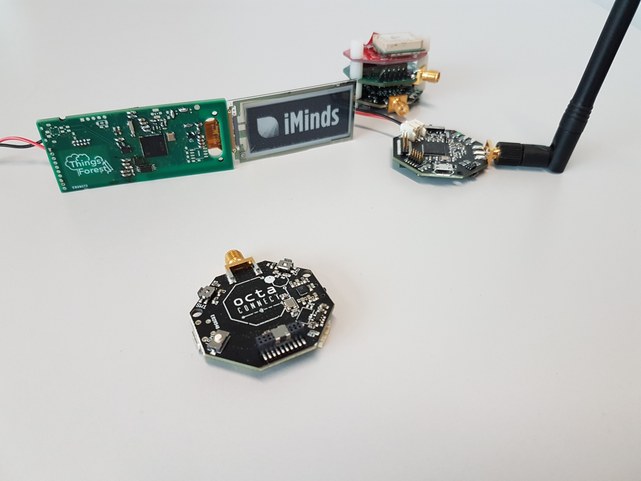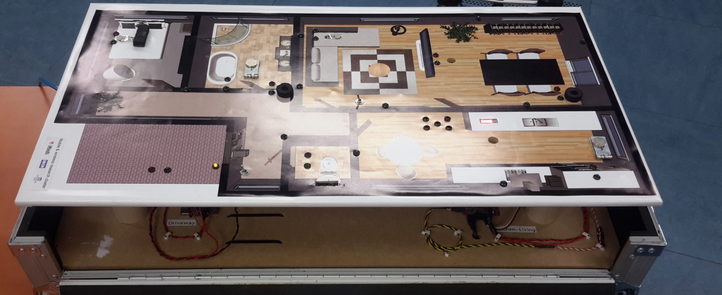Resource Constrained IoT Devices & Networks
To enable reliable IoT applications using small, low power, battery operated devices different design tradeoffs have to be considered, both in hardware, communication and software implementations. To cope with these diverging requirements, this research priority focuses on the following aspects: (i) improvements of IoT communication protocols and technologies, (ii) sub-GHz IoT solutions, (iii) multi-technology solutions and (iv) testing and validation of IoT solutions.
Improvements of IoT communication protocols and technologies.
To enable challenging IoT applications with demanding and heterogeneous application requirements, IDLab assesses, extends and improves state-of-the-art IoT communication technologies (IEEE 802.11ah, 802.15.4, low-power Wi-Fi, BLE) and protocols that are suitable for resource constrained devices. These activities include the design of resource allocation protocols, improving resilience and robustness of communication and decreasing the energy consumption. To cope with the stringent energy requirements of constrained devices, IDLab has designed the TAISC architecture, that allows the design of highly energy efficient MAC protocols for constrained devices.
With respect to the higher-layer integration of constrained devices in IoT applications (e.g. web services), IDLab develops novel IoT application enablers, with a prime focus on the Constrained Application Protocol. These enablers either facilitate the creation of IoT applications (e.g. grouping of CoAP resources, bindings, RESTlets, middleware to abstract heterogeneity, etc.), reduce the overhead on constrained networks (resource virtualization, security termination, etc.) or improve user interactions with embedded devices (smart HTTP/CoAP proxying, easy configuration). For this, IDLab has the availability over a flexible and modular prototyping platform (CoAP++).
Sub-GHz IoT solutions. A plethora of new low-power wireless networking standards have been proposed during the last five years. For cost-efficiency and deployment ease reasons, they often employ license-exempt sub-1GHz bands (i.e., 433~MHz and 868/915~MHz). Examples are IEEE 802.15.4g for Smart Utility Networks, DASH7, adopted from ISO 18000-7 and IEEE 802.11ah, the newest member of the Wi-Fi family. These technologies can be classified as mid-range (up to 1~km) and mostly focus on private deployments. At the same time, new technologies for Low Power Wide Area Networks, such as Sigfox and LoRa, are being deployed. In contrast, they enable low power communication with ranges up to 30~km, but with more limitations in terms of throughput and latency than mid-range technologies. Moreover, their energy consumption per transmitted bit is much higher. IDLab investigates the communication stacks of these protocols to optimize the power, and resource allocation based on the applications needs.
Multi-technology solutions. Furthermore, to cope with the presence of an increasing number of wireless IoT technologies, IDLab also investigates, designs and improves ubiquitous solutions that transparently support a plethora of technologies (e.g., LoRa, DASH7, IEEE 802.15.4g,), targeting co-creation of hardware prototyping and embedded protocol stack design as well as improved interactions with embedded devices.
Testing and validation of IoT solutions.
To test and validate the above mentioned modules and create detailed energy consumption modules, a versatile hardware prototyping platform is further developed which is used for communication stack testing, sensor integration and proof of concepts. Several large scale wireless testing facilities are also available to assess and improve the performance in different environments (office, home building, factory environment and smart city context).
Staff
Chris Blondia, Eli De Poorter, Jeroen Famaey, Jeroen Hoebeke, Steven Latré, Ingrid Moerman, Ingrid Moerman, Maarten Weyn
Researchers
Jan Bauwens, Rafael Berkvens, Noori Bni Lam, Enri Dalipi, Glenn Daneels, Stijn Denis,, Glenn Ergeerts, Jetmir Haxhibeqiri, Bart Jooris, Abdulkadir Karagaac, Girum Ketema, Merima Kulin, Dragan Subotic, Jen Rossey, Peter Ruckebusch, Le Tian, Floris Van den Abeele
Projects
- ARTEMIS DEWI: Dependable Embedded Wireless Infrastructure
- ITEA2 FUSE-IT: Facility Using smart Secured Energy & Information Technology
- ICON MoniCow: More Efficient Cattle Monitoring Through an Advanced Data System
- ICON HYCOWARE: Hybrid Connected Warehouses
- ICON iFEST - improved festival experience through wireless technology
- ICON COMACOD: Control and Management of Constrained Devices
- GOA Disposable and biodegradable wireless networks for extreme conditions
- VIS Mechatronics 4.0 - Towards connected, autonomous industrial machines
- Interreg Smart Tooling - Smart tooling for the process industry
- H2020 WISHFUL - Wireless Software and Hardware platforms for Flexible and Unified radio and network controL
- FWO-SBO SAMURAI - Software Architectures and Modules for unified radio control
Key publications
- Maarten Weyn, Glenn Ergeerts, Rafael Berkvens, Bartosz Wojciechowski, Yordan Tabakov “DASH7 alliance protocol 1.0 : low-power, mid-range sensor and actuator communication”, IEEE Conference on Standards for Communications and Networking (CSCN), OCT 28-30, 2015, Tokyo, JAPAN - ISBN 978-1-4799-8927-0 - New york, Ieee, (2015), p. 54-59
- Isam Ishaq, Jeroen Hoebeke, Ingrid Moerman and Piet Demeester, “Experimental Evaluation of Unicast and Multicast CoAP Group Communication”, Sensors 2016, 16(7), 1137, doi:10.3390/s16071137
- Floris Van den Abeele, Jeroen Hoebeke, Girum Ketema Teklemariam, Ingrid Moerman, Piet Demeester, “Sensor Function Virtualization to Support Distributed Intelligence in the Internet of Things”, Wireless Personal Communications, Volume 81, Issue 4, pp 1415-1436, April 2015
- Ergeerts Glenn, Nikodem Maciej, Subotic Dragan, Surmacz Tomasz Wojciechowski, Bartosz De Meulenaere Paul and Weyn Maarten , “DASH7 alliance protocol in monitoring applications”, 10th International Conference on P2P, Parallel, Grid, Cloud and Internet Computing (3PGCIC), November 4-6, 2015, Krakow, Poland- p. 623-628
- Bart Jooris, Jan Bauwens, Peter Ruckebusch, Peter De Valck, Christophe Van Praet, Ingrid Moerman, Eli De Poorter, "TAISC: a cross-platform MAC protocol compiler and execution engine", Computer Networks, doi:10.1016/j.comnet.2016.03.027 (2016)
- Peter Ruckebusch, Jan Bauwens, Bart Jooris, Spilios Giannoulis, Eli De Poorter, Ingrid Moerman, Domenico Garlisi, Pierluigi Gallo, and Ilenia Tinnirello. "Cross-technology wireless experimentation: Improving 802.11 and 802.15. 4e coexistence." In World of Wireless, Mobile and Multimedia Networks (WoWMoM), 2016 IEEE 17th International Symposium on A, pp. 1-3. IEEE, 2016.
- Le Tian, Steven Latré, Jeroen Famaey. Evaluation of the IEEE 802.11ah Restricted Access Window Mechanism for dense IoT networks. Seventeenth International Symposium on a World of Wireless, Mobile and Multimedia Networks (WoWMoM), Ciombra, Portugal, 2016.


